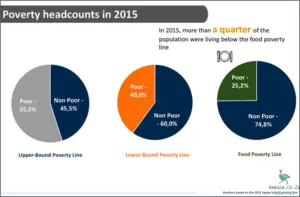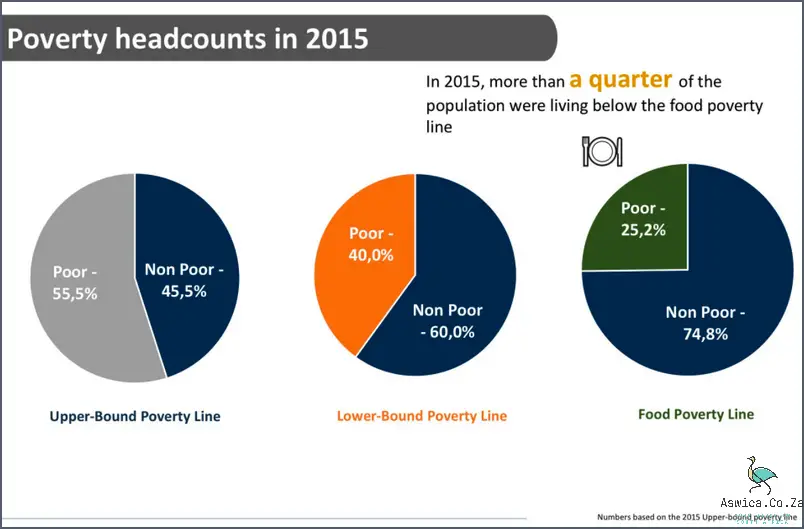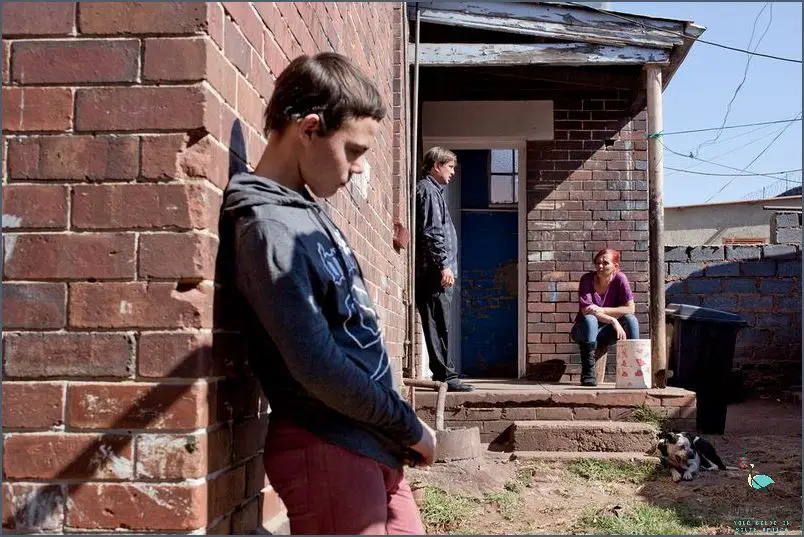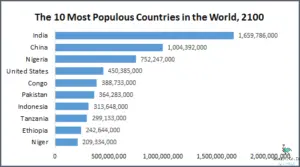
South Africa is one of the most unequal countries in the world, with a large number of people living in poverty. Poverty levels in South Africa are measured in terms of income, access to resources, and quality of life. The poverty levels in South Africa range from extreme poverty to relative poverty.
Extreme poverty is defined as having an income of less than $1.90 (USD) per day. This level of poverty is the most severe in South Africa, with the majority of people living in extreme poverty living in rural areas. People living in extreme poverty often lack access to basic services such as healthcare, clean water, and sanitation. Many of these people also experience food insecurity and malnutrition due to limited access to food.
Relative poverty is defined as having an income of less than 50% of the median national income. This level of poverty is more common in urban areas, where people often lack access to basic services such as housing, education, and employment. Those living in relative poverty often struggle to meet their basic needs and experience social exclusion.
In addition to these two poverty levels, there is also the vulnerable level of poverty. This level of poverty is defined as having an income of between 50% and
Contents
What Are The Levels Of Poverty In South Africa
South Africa has one of the most unequal societies in the world, with extreme levels of poverty. The levels of poverty in South Africa can be broken down into four distinct categories: Extreme poverty, Moderate poverty, Vulnerable poverty and Relative poverty. Extreme poverty is the most severe, with individuals surviving on less than R465 per month. Moderate poverty is when individuals survive on between R465 and R931 per month. Vulnerable poverty is when individuals survive on between R931 and R1496 per month. Relative poverty is when individuals survive on between R1496 and R2541 per month. These levels of poverty are shockingly high and have a severe impact on the lives of South Africans.
Overview of poverty levels in South Africa
Poverty levels in South Africa are a pressing concern for the nation’s people, government, and international organizations. According to a recent report by the World Bank, South Africa is one of the most unequal countries in the world, with the highest Gini coefficient of any major economy. This means that the disparity between the nation’s rich and poor is extreme, with the majority of the population living in poverty.
The situation is particularly concerning when considering the fact that the poverty levels in South Africa have remained largely unchanged for the past two decades. This has led to an increase in the number of people living in extreme poverty, with the most recent estimates suggesting that over 30% of the population survives on less than $2 per day.
The drivers of poverty in South Africa are complex, but can be broadly categorized as follows:

• High unemployment rate: South Africa’s unemployment rate has been consistently high for years, and currently stands at more than 27%. This has led to a lack of economic opportunities for many, contributing to the nation’s high poverty levels.
• Inequality: South Africa is one of the most unequal countries in the world, with a significant gap between the rich and the poor. This has resulted in a large portion of the population being unable to access basic services and amenities, or to improve their quality of life.
• Decline in agriculture: Agriculture is a key industry in South Africa, yet the sector has seen a decline in recent years, leading to a decrease in employment opportunities and a rise in poverty.
• Limited access to education: Education is essential for economic growth and development, yet many South Africans are unable to access quality education due to a lack of resources. This has resulted in a lack of skills among the population, leading to limited job opportunities and a higher risk of poverty.
The South African government and international organizations have taken steps to address the poverty levels in the country, including providing basic services and economic opportunities for the most vulnerable members of society. Nonetheless, more needs to be done in order to reduce poverty levels and ensure that all South Africans have access to the resources they need to lead a comfortable life.
Factors causing poverty in South Africa
Poverty in South Africa is a pervasive and complex issue, with numerous contributing factors that have caused its prevalence and persistence. While there are many factors, some of the most prominent include income inequality, unemployment, and inadequate access to basic services. Here, we will explore the levels of poverty in South Africa, and the factors causing it.
Income inequality is a major driving force of poverty in South Africa. According to the World Bank, South Africa has the highest level of income inequality in the world, with a Gini coefficient of 0.63. This means that the wealthy and powerful few have a disproportionate share of wealth, while the majority of South Africans are left with little to nothing. This inequality is perpetuated by the legacy of Apartheid-era policies, which entrenched the racial divide between whites and non-whites, leaving many black South Africans in poverty.
Unemployment is another key factor driving poverty in South Africa. According to Statistics South Africa, the official unemployment rate is currently at 30.1%, with over 6.2 million people unemployed. This rate is even higher for young people and rural populations. The lack of employment opportunities means that many South Africans are unable to meet their basic needs, such as food, shelter, and healthcare.
Inadequate access to basic services is also a major cause of poverty in South Africa. Many South Africans do not have access to clean water, sanitation, healthcare, and education. This means that those living in poverty are unable to take advantage of the opportunities available to them and are more likely to stay in poverty.

The levels of poverty in South Africa are alarming, and its causes are complex. In order to address this issue, there must be a multi-faceted approach that addresses income inequality, unemployment, and inadequate access to basic services. Only then can South Africa begin to make progress in reducing poverty and creating a more equal society.
Types of poverty in South Africa
Poverty in South Africa is a pervasive issue that affects millions of people. While poverty exists in all parts of the world, South Africa’s unique history, culture, and geography make it especially vulnerable to extreme levels of deprivation. The South African government, in partnership with international organizations, has developed various classifications of poverty to better understand the different types of deprivation in the country.
The most common type of poverty in South Africa is known as absolute poverty. This type of poverty is defined as a lack of basic resources such as food, shelter, and clothing. People who face absolute poverty suffer from malnutrition, inadequate housing, and lack of access to essential services such as education and healthcare. This type of poverty is most common in rural areas and among people with lower levels of education and income.
Another type of poverty in South Africa is relative poverty. This type of poverty is defined as a lack of resources compared to the average standards of the society. People who live in relative poverty may have access to basic necessities, but their quality of life is lower than the average standards of their society. This type of poverty is most common in urban areas, where the cost of living is higher and resources are more limited.
The third type of poverty in South Africa is known as structural poverty. This type of poverty is caused by a lack of access to resources due to structural factors such as discrimination, inequality, and lack of opportunities. People who live in structural poverty often lack access to basic services such as education, healthcare, and employment. This type of poverty is most common in areas with high levels of inequality and discrimination.
The South African government has adopted a multi-level approach to tackle poverty, with various initiatives in place to reduce poverty among different groups. These initiatives include providing access to basic services such as education and healthcare, increasing opportunities for employment and economic growth, and creating safety nets for vulnerable populations. Through these initiatives, the government is striving to reduce poverty in all its forms in South Africa.
Conclusion
In South Africa, there are many levels of poverty. The most impoverished people live in townships, rural areas, and informal settlements. They experience high levels of poverty, lack of education and health care, and poor living conditions.
The level of poverty in South Africa is highly uneven. It varies from one area of the country to the next, and from one sector of the economy to the next. Low-income households experience the most severe levels of poverty. They are almost three times as likely to be living in poverty as high-income households.
The main factors that contribute to poverty in South Africa are unemployment, low wages, poor working conditions, and little or no access to social services. These factors are also responsible for the high levels of inequality in South Africa.
The government of South Africa is working to reduce the level of poverty in the country. It is investing in education and health care, and it is providing social services to low-income households. In addition, the government is working to reduce the level of inequality in South Africa.




